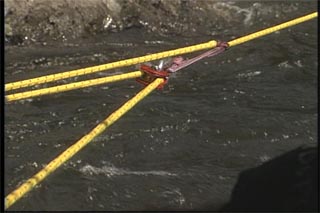Safety rules
Strategically placed dampers (counterweights) can quickly limit the projection of a carabineer or pulley if the system breaks. Extra Prussik attachments can be used as a brake to allow you to advance the Z Drag system. Another approach is a tensionless belay hitch. The person closest to the Z Drag system should face away from the set-up and wear a PFD and helmet for protection. In fact, all participants should wear these items. Consider an extra pulley or carabineer for a direction change to take the pullers out of the line of fire. If possible, assign a non-puller to watch the Prussik on the traveling pulley for any signs of slippage along the rope. A tag line attached to the end of the boat and hooked up to a tensionless hitch is wise to prevent a runaway boat once it is freed. Here is a video we made where we intentionally exercises a Z Drag failure: Z-Drag to Failure. Notice the third try which used a couple of frayed shoe laces. We managed to get quite a snap even with that weak link - anyone in the line of fire would sustain quite an injury. Z Drag failures with ropes can impale a piece of plywood with a carabineer - plan well and be very careful.
Places team at higher risk, takes time, and is complex
In general, the greater the complexity - the greater chance for errors. When working with significant forces as described above, set-up errors can cause a rope to snap or send an attachment like a carabineer or pulley flying like a bullet. Getting hit by a snapped line or carabineer can cause serious injury. You really need to evaluate the strength of your rope and anchors to ensure nothing can break.
The Z Drag isn't something we practice very much so it can take some time to figure out. It also takes time to locate and set-up suitable anchors for this system. Add additional time for safety dampers and brakes and 20 - 30 minutes can go by very quickly. Compare this to simpler methods like the Armstrong method, vector pull, and simple turning - all of which are safer and much faster.
For these reasons, avoid heavy mechanical advantage systems when rescuing a pinned boater. Often time is of the essence for a trapped paddler. If possible, extract the boater and deal with boat recovery when everyone has had a chance to rest.
Key for advanced unpinning techniques and rope rescues
Water exerts a great deal of force on objects. The following chart is from River Rescue, 4th Edition - Les Bechdel & Slim Ray:
| The Force of Current | |||
| Current Velocity | Average Total Force of Water (Foot Pounds) | ||
| MPH | On Legs | On Body | On Swamped Boat |
| 3 | 16.8 | 33.6 | 168.0 |
| 6 | 67.2 | 134.0 | 672.0 |
| 9 | 151.0 | 302.0 | 1512.0 |
| 12 | 269.0 | 538.0 | 2688.0 |
The force increases in proportion to the square of the water velocity. Water is heavy as well, it weighs 62.4 lbs per cubic foot (or 8.35 lbs/gal). Figure an average kayak holds 75 gallons without air bags, the total weight is: (75 * 8.35) + 40 (average kayak weight) or 666 Pounds. Now you can understand why we insist on paddlers installing air bags in their boats.
As you can see, these numbers add up quickly. If you are paddling in a small party like 3/4 boaters, you will may need some form of leverage to extract a pinned boat.
Mechanical Advantage
 For many, this is the most interesting and fun part of the SWR course. Unfortunately, it can also be the most dangerous. For the most part, mechanical advantage techniques are used to unpin boats or rafts - not people. This is a good thing since you can and should take time to plan your strategy. Always remember the KISS approach and attempt the least complex methods like direct tugging first. On many boating runs, you can get assistance from boaters in other parties for the Armstrong (10 Boy Scouts) method. True mechanical advantage systems like the Z Drag or Pig Rig should wait until the other, less complicated approaches have been exhausted and you simply lack adequate manpower.
For many, this is the most interesting and fun part of the SWR course. Unfortunately, it can also be the most dangerous. For the most part, mechanical advantage techniques are used to unpin boats or rafts - not people. This is a good thing since you can and should take time to plan your strategy. Always remember the KISS approach and attempt the least complex methods like direct tugging first. On many boating runs, you can get assistance from boaters in other parties for the Armstrong (10 Boy Scouts) method. True mechanical advantage systems like the Z Drag or Pig Rig should wait until the other, less complicated approaches have been exhausted and you simply lack adequate manpower.
Page 3 of 3
